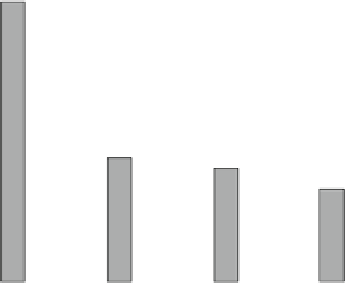Environmental Engineering Reference
In-Depth Information
Table 2.5
Cadmium, lead and zinc content (mg kg
−
1
) of coal and different sorts of ashes (from:
different sources, e.g. Meuser
1996
)
Cadmium (Cd)
Lead (Pb)
Zinc (Zn)
Hard coal (raw material)
0.1
40
50
Bottom ash of coal power stations
2.1
82
72
Fly ash of coal power stations
14
1,080
990
Bottom ash of garbage incinerators
33
2,088
4,538
Fly ash of garbage incinerators
316
6,935
2.1%
the values of the coarse bottom ashes. Accordingly, it can be expected that differ-
ent total concentration might lead to different mobile concentration between the
technogenic materials.
In general, the texture influences the contamination level, since fine earth is
able to adsorb more cations (e.g. cadmium, lead, zinc) than the coarse fractions.
Therefore, some technogenic material consisting of silt or clay may be more
contaminated. For instance, harbor sludge fields in Hamburg, Germany, show dif-
ferent heavy metal values, depending on the texture class (Fig.
2.9
). On the other
hand, it should be noted that areas consisting of mixtures between soil and coarse
unweathered technogenic materials such as slag can show a higher contaminant
concentration in the sandy and gravely fraction than in the silty and clayey.
In Table
2.6
the expected contaminant situation related to the different artificial
components is summarized (Meuser and Blume
2004
). The most important artifi-
cial component group is
construction rubble
, derived from buildings that have been
removed. If decontamination of potentially problematic materials with contaminants
and dismantling processes in a controlled manner is not possible, materials passing
the demolition operations continuously contain contaminants, causing enhanced
total concentration
s andy fraction
muddy silt
180
160
140
120
100
80
60
Fig. 2.9
Heavy metal
concentrations (mg kg
−
1
)of
harbor dredged sludges
divided into different texture
classes in Hamburg, Germany
(unpublished)
40
20
0
Pb
Hg x 10
Cd x 10
As

























Search WWH ::

Custom Search